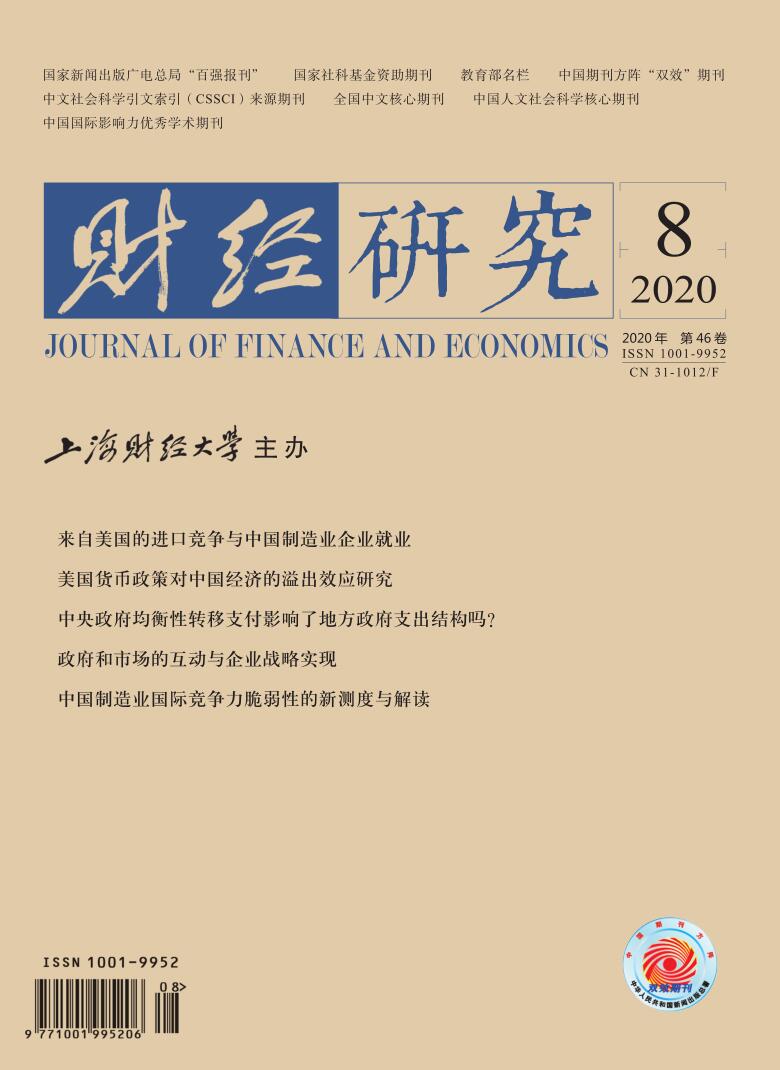[1]Cao Q F. High housing price, expansion of fictitious economy sector and the labor income share[J]. Finance & Economics, 2018, (11): 61-69. (In Chinese)
[2]Cheng S W. The virtual economy cannot be expanded[J]. Capital Markets, 2015, (1): 8. (In Chinese)
[3]Du Y, Zhang H, Chen J Y. The impact of financialization on future development of real enterprises’ core business: Promotion or inhibition[J]. China Industrial Economics, 2017, (12): 113-131. (In Chinese)
[4]Hu Y M, Wang X T, Zhang J. The motivation for financial asset allocation: Reservoir or substitution? Evidence from Chinese listed companies[J]. Economic Research Journal, 2017, (1): 181-194. (In Chinese)
[5]Huang X H, Wu Q S, Wang Y. Financial asset allocation and financial risks of enterprises: “Precautions” or “bartering”[J]. Journal of Finance and Economics, 2018, (12): 100-112. (In Chinese)
[6]Li Z S, Su C, Li H, Kong D M. Excess leverage and region-based corporate peer effects[J]. Journal of Financial Research, 2018, (9): 74-90. (In Chinese)
[7]Liu J, Sheng H Q, Ma Y. The mechanism of corporate enterprise participating in shadow banking business and its model analysis of social-welfare net loss[J]. Journal of Financial Research, 2014, (5): 96-109. (In Chinese)
[8]Liu W, Cao Y Q. Do institutional investors drive financialization of real sectors?[J]. Finance & Trade Economics, 2018, (12): 80-94. (In Chinese)
[9]Lu R, Chang W. Peer effect in corporate fraud[J]. Journal of Financial Research, 2018, (8): 172-189. (In Chinese)
[10]Lu R, Wang C, Deng M M. “Peer effect” in capital structure of China’s listed firms[J]. Business Management Journal, 2017, (1): 181-194. (In Chinese)
[11]Peng Y C, Han X, Li J J. Economic policy uncertainty and corporate financialization[J]. China Industrial Economics, 2018a, (1): 137-155. (In Chinese)
[12]Peng Y C, Ni X R, Shen J. The effect of transforming the economy from substantial to fictitious on financial market stability: An analysis on stock price crash risk[J]. Economic Research Journal, 2018b, (10): 50-66. (In Chinese)
[13]Shi G F. Local government intervention and peer effect of firm investment[J]. Journal of Finance and Economics, 2015, (12): 84-94. (In Chinese)
[14]Wang H J, Cao Y Q, Yang Q, Yang Z. Does the financialization of non-financial enterprises promote or inhibit corporate innovation[J]. Nankai Business Review, 2017, (1): 155-166. (In Chinese)
[15]Wang Y Q. Liu Z H, Li E, Du J L. Identifying non-financial firm’s shadow banking activities in China: Evidence from consolidated balance sheets[J]. Management World, 2015, (12): 24-40. (In Chinese)
[16] Xia L J, Fang Y Q. Government control, institutional environment and firm value: Evidence from the Chinese securities market[J]. Economic Research Journal, 2005, (5): 40-51. (In Chinese)
[17]Zhang C S, Zhang B T. The falling real investment puzzle: A view from financialization[J]. Economic Research Journal, 2016, (12): 32-46. (In Chinese)
[18]Zhang T Y, Zhong T L. Peer effects in financial decision making: A literature review and future research outlook[J]. Foreign Economics & Management, 2018, (11): 3-16. (In Chinese)
[19]Zhao Y. Analysis of CEOs’ compensations’ peer effects from China listed companies[J]. China Industrial Economics, 2016, (2): 114-129. (In Chinese)
[20]Adhikari B K, Agrawal A. Peer influence on payout policies[J]. Journal of Corporate Finance, 2018, 48: 615-637.
[21]Baker S R, Bloom N, Davis S J. Measuring economic policy uncertainty[J]. The quarterly Journal of Economics, 2016, 131(4): 1593-1636.
[22]Bird A, Edwards A, Ruchti T G. Taxes and peer effects[J]. The Accounting Review, 2018, 93(5): 97-117.
[23]Bustamante M C, Fresard L. Does firm investment respond to peers' investment?[R]. Robert H. Smith School Research Paper No. RHS 2827803, 2017.
[24]Cai H, Fang H, Xu L C. Eat, drink, firms, government: An investigation of corruption from the entertainment and travel costs of Chinese firms[J]. Journal of Law and Economics, 2011, 54(1): 55-78.
[25]Demir F. Financial liberalization, private investment and portfolio choice: Financialization of real sectors in emerging markets[J]. Journal of Development Economics, 2009, 88(2): 314-324.
[26]Dougal C, Parsons C A, Titman S. Urban vibrancy and corporate growth[J]. The Journal of Finance, 2015, 70(1): 163-210.
[27]Duong H K, Ngo A D, McGowan C B. Industry peer effect and the maturity structure of corporate debt[J]. Managerial Finance, 2015, 41(7): 714-733.
[28]Firth M, Fung P M Y, Rui O M. Corporate performance and CEO compensation in China[J]. Journal of Corporate Finance, 2006, 12(4): 693-714.
[29]Graham J R. Herding among investment newsletters: Theory and evidence[J]. The Journal of Finance, 1999, 54(1): 237-268
[30]Graham J R, Harvey C R. The theory and practice of corporate finance: Evidence from the field[J]. Journal of financial economics, 2001, 60(2-3): 187-243.
[31]Grennan J P. Dividend payments as a response to peer influence[J]. Journal of Financial Economics, 2019, 131(3): 549-570.
[32]Gul F A, Kim J B, Qiu A A. Ownership concentration, foreign shareholding, audit quality, and stock price synchronicity: Evidence from China[J]. Journal of Financial Economics, 2010, 95(3): 425-442.
[33]Leary M T, Roberts M R. Do peer firms affect corporate financial policy?[J]. The Journal of Finance, 2014, 69(1): 139-178.
[34]Lieberman M B, Asaba S. Why do firms imitate each other?[J]. Academy of Management Review, 2006, 31(2): 366-385.
[35]Morck R, Yeung B, Yu W. The information content of stock markets: Why do emerging markets have synchronous stock price movements?[J]. Journal of Financial Economics, 2000, 58(1): 215-260.
[36]Scharfstein D S, Stein J C. Herd behavior and investment[J]. American Economic Review, 1990, 80(3): 465-479.
[37]Shin H S, Zhao L. Firms as surrogate intermediaries: Evidence from emerging economies[R]. Asian Development Bank Working Paper, 2013.
[38]Smallwood D E, Conlisk J. Product quality in markets where consumers are imperfectly informed[J]. Quarterly Journal of Economics, 1979, 93(1): 1-23.
[39]Stock J H, Yogo M. Identification and inference for econometric models: Asymptotic distributions of instrumental variables statistics with many instruments[J]. Journal of the American Statistical Association, 2005, 89(2): 1319-1320.
[40]Stulz R M. Rethinking risk management[J]. Journal of Applied Corporate Finance, 1996, 9(3): 8-25.
[41]Tori D, Onaran O. The effects of financialisation and financial development on investment: Evidence from firm-level data in Europe[R]. Working Paper, 2017.






 5447
5447  7230
7230

